Voter Registration – Ray Cox, strip joints, and voter fraud
October 6th, 2005
Ray’s got another one of his inane blogs posted, Photo Identification for Voters, about voter registration. His vague complaints seem to be targeted at voter qualification on election day at the polls. He claims that “Many of these ?non-voters? fail to vote because they don?t want to wait in long lines.” He’d better check causes of long lines — maybe it’s 25B voting patterns and because voter turnout is unbelievably high! If you look at the Scott County precincts of 25B, you’ll find an average voter turnout of over 90%. Long lines are caused by high voter turnout and insufficient staffing and not enough voting booths.
Why would he take these positions on voter registration, when it appears that voters indeed turn out for 25B elections? Or is his problem that high turnout in Minnesota historically favors the DFL?
Has there been voter fraud in 25B? In Minnesota? Is it a big issue anywhere???? Something tells me he’s not thinking about the massive fraud in the last two Presidential elections…
From MAPE‘s Workday Minnesota:
Here is the complete list of ways to register on Election Day:
– MN Driver’s license, learner’s permit, identification card, or receipt for any of these, with your current address
– Tribal ID from a federally recognized Indian Tribe located in Minnesota, which has a photo, your name and current address
– For students, a Registration or Fee statement with the student’s name and address, along with a photo ID
– “Notice of Late Registration” postcard from the Secretary of State
– Original utility bill dated within 30 days of the election with voter’s name and current address, along with a photo ID (including Military ID, U.S. Passport, Student ID, MN ID, or Tribal ID)
– Someone who is registered in the precinct who has personal knowledge that you live in the district and will vouch for you
– Student ID with a photo for students who live on campus, if your college provided the county with a certified list of students
– If you live at a residential facility, an employee at the facility can vouch that you live in the district, if the facility provided the county with a list of employees 20 days before the election.
Cox makes the same bogus claim about voter registration that he makes about Environmental Assessment Worksheets (Ag or generally?), that it’s been “abused.” Really! Here’s the quote:
Voting is a privilege and a right, but there are people that abuse the system.
Abuse the system? HUH? How prevalent is voter fraud? How many instances of voter fraud have there been recently?
Who’s abusing the voter registration system?

Ray Cox could cite one of the biggest cases of voter fraud in U.S. history, right here in his own front yard, but he doesn’t mention it! Do you remember the “Jake’s” case?
Voting Fraud Aimed at Benefiting Strip Club
Thursday, October 17, 2002COATES, Minn. ? Dakota County prosecutors charged 95 people Wednesday in an alleged scheme to rig elections in the small town of Coates for the benefit of a strip club that officials have long been trying to shut down.
County Attorney James Backstrom said 94 of the defendants filled out voter registration cards claiming they lived at the same address. The address turned out to be that of the club, named Jake’s.
Prosecutors charged Jake’s owner Richard J. Jacobson, 32, of Prescott, Wis., with conspiracy to commit forgery and conspiracy to commit unlawful voting, another felony, for allegedly orchestrating the scheme. The other 94 all were charged with forgery and conspiracy to commit forgery. All the charges are felonies.
Backstrom said he believed some of the defendants were employees at Jake’s, but he thought most were customers who might have been duped into signing the registration cards.
Reached at the club, Jacobson declined to comment on the voter fraud allegations. But he said his battle has been going on for 11 years and described the situation as “a small town run amok, with a Nazi mayor and a bunch of sheep as councilmen.”
Jacobson’s attorney, Randall Tigue, said he had not reviewed the charges but had read a news release from Backstrom’s office describing them. Based on that, he said he doubted a crime had been committed.
This case of voter fraud wasn’t about unqualified individual voters lining up at the polls, it was an issue of a guy orchestrating an effort to force his will over a community’s ability to determine the character of the city, corporate v. local control. He was losing, the city was shutting him down, and here’s the extent he went to to prevail. The problem is one of economic coercion of employees and collusion with patrons. I’ve got a copy of the long list of those charged in this case, a few familiar names… Registration was done through the mail on registration forms, not through on-site election day registration.
Voter Registration Fraud in Minnesota
Justice cracks down on voter fraudMarijuana, $70,000 seized at strip club involved in voter fraud scandal
This is the only reference to a case of voter fraud that I’ve been able to find.
So where’s the problem, Ray? What are you really getting at?
Maybe the Secretary of State is going to get sued again… her ideas on voting rights are scary… draconian federal regs would keep Kiffmeyer out of the hot seat!
Looking at our energy world through solar
October 5th, 2005
Right now we’re feeling an annular solar eclipse of the sun, other things too, it’s an intense time for everyone, time to wake up, face reality, do it different, get with the program and get a grip on life! In the words of Eric Francis:
For sure, eclipses can SUCK. They can be wrenching, they can derail us, they can induce amnesia, they can portend locusts and pestilences. And this can be fabulous, too: they are, very consistently, those times in which we put the past behind us, as Sting said: sooner or later, just like the world’s first day, sooner or later, we learn to throw the past away.*
Rarely is this simple, or one-dimensional: Ah, how nice, the past is over. Time to move on. It can be…! Truly.
But not always. Sometimes all the agonizing on the way to getting to the point of letting go can leave us with some post traumatic stress. But not always; not even usually; we are living in the times of It Is Time, and that’s what an eclipse says. Andiamo, allons-y, on with the show, or, in the immortal words of my brother, broadcast authoritatively from the roof-mounted loudspeaker of his van (generally reserved for traffic jams), “Move your fuckin’ parade!”

The eve of an eclipse was a fitting time for the Solar Tour, we need to do energy differently and it feels to me like a binary time — we cannot continue on this fossil fuel/central station power path. I’d sent this Guest Column in to appear as a prelude to the Solar Tour, oh well, here it is in today’s Northfield News — can’t have me sharing Guest Column space with Ray Cox after all!

Looking at our energy future through solar
Saturday was the Solar Tour, where homes and businesses were open to see what’s possible, from commercial buildings filled with solar panels to passive solar additions and home-sized installations for homes like yours.
Solar isn’t anything that complicated or odd or arcane; renewable energy is a solid investment, complete with rebates, to take control of energy generation.
It’s everywhere you look, and each day people are conserving and generating their own electricity.
But on the other hand, from the transmission owners recently released plans to build a web of big transmission lines in Minnesota to those who continue to buy SUVs, I’m shaking my head a lot lately … whatever are they thinking?
This is not the energy future I envision, it’s not what I’m working for, and it’s not the world I want to live in. Yes, I’m utterly disgusted with this direction and looking at tico houses in Costa Rica but my work here isn’t done yet. How ?bout each of you? Are you accepting this energy nightmare or are you doing something about it. Energy is binary!
What’s got me reeling is the speed with which the utilities are taking advantage of the transmission policy gains made last legislative session, specifically the announcement of “Phase I” of the transmission owners’ plan to cross the state many times over with big lines that enable bulk power transfers. The primary legislative changes that make this possible are the switch from requiring a Minnesota-based need demonstration to a demonstration of regional need; enactment of an “automatic adjustment” for transmission claimed to be for renewable energy; and legislative approval of transmission only entities that will trigger the shift of control over transmission from state to the feds.
These policy steps were part of a 2003 agreement that utilities made with environmental groups that should know better; they have now become law after being ushered through the legislature by these same groups. We’re starting to see the utility horses launching themselves out of the gate.
Who cares about electric transmission? It’s not something people think about; it’s just there, everywhere we go, and becomes part of our assumptions. It’s a subtle thing. Someone I know urges surreptitiously painting transmission lines on the masters’ landscapes, and decades ago in China, government directed transmission lines be added to artists works to promote electrification of the country! A former state energy policy wonk now working for a utility put it simply: “If you let us build transmission, we’ll build coal plants, and if you don’t, we’ll have to do distributed generation.”
Electricity is indeed binary; if we build billions of dollars of transmission infrastructure with its 35-year financing and 50-year life span, we are committed to 50 years of coal plants and central station power, big power plants with big long transmission lines. Do we want big, long transmission lines? Do we want more coal plants? Do we want re-licensed nuclear plants? They have the go-ahead for transmission; it’s being built; and the big generating plants will come.
What’s wrong with that? Ask the women of the Northfield area who are advised by their prenatal care providers not to eat fish. Ask the residents of Becker who are neighbors of coal plants who every morning sweep coal plant emission dust off their cars. Ask the residents of Prairie Island Indian Community who learn of an “incident” at the nuclear plant by the rush of employee cars out of the plant. Ask the Minnesota landowners with $1 easements for the new Arrowhead transmission line about the recent Douglas County settlement for “under $1 million” for easements for that same line. Ask the municipal utilities and co-ops who fight to get their share of transmission to serve their customers when transmission owners want to increase bulk power transfers for export.
By each of us doing our part, we can shape a hopeful energy future, whether by solar and geothermal installations in our home for electricity and heat, or by enabling local-distributed generation or advocating sensible energy policy. Our energy future must be one of distributed generation with small plants built near the load, one of non-toxic generation, transmission and distribution that builds our local economy. That’s an energy future we can live with.
— Carol Overland is a utility regulatory attorney and a Northfield business owner.
Solar Tour 2005
October 4th, 2005
How do we do energy different? Solar is so passive… yawn… it doesn’t really jump up and do anything, but thanks to the Minnesota Renewable Energy Society, and sponsors Xcel Energy, Aveda and Great River Energy, we can spend a beautiful fall day on the Solar Tour 2005 learning exactly how others are doing it! And that’s anything but passive! Those who opened their homes to the masses were inspiring.
Here’s the Brorn home, in Winona:
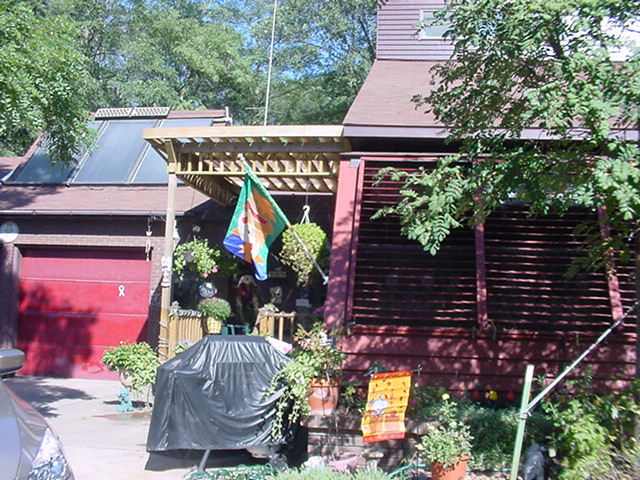
They built it themselves, and in addition to solar hot water, they have been continuously updating, everything from reinsulating parts of the roof that weren’t quite right, to louvers over southern windows to shelter the interior from direct sunlight, to a … well, look at the photo, the wood shade over the front porch… don’t know what to call it. They also had a Honda Accord hybrid on display, but the mileage was only about 30mpg on the highway, not any better than my vintage Diamante. That was the only disappointment of the day.
Next up was the Huelskamp/Hutchinson off-grid home. Rich is a renewable energy contractor, designer, etc., as Sun’s Warmth, and their dome home is amazing, very comfortable, beautifully built, and it’s easy to imagine living like that! Here’s the shop with solar, the wind turbine in the background, and the electric solar is behind the shop.
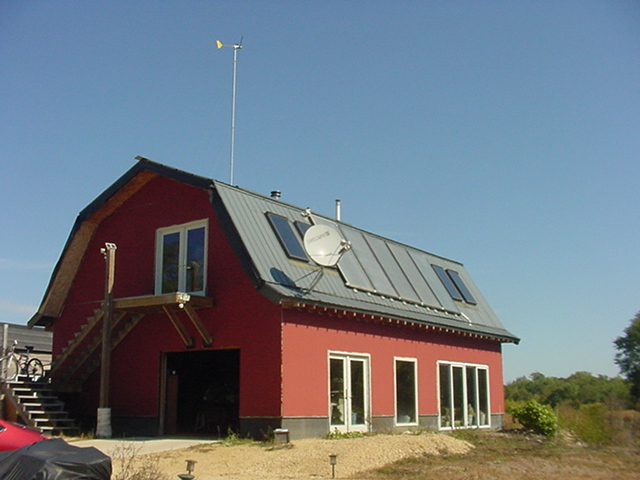
I had an errand to run in the cities, so the Garvin/Jacobson home was the next stop, near the old ‘hood, in Seward neighborhood. Their home was a great example of what regular people can do, and again, it was done beautifully, so much so that their back yard was an oasis from the city. Peonies were available for the taking, and at that point I noticed that there is a direct correlation between park-like yards covered in wild varieties of plants, anything but BORING GREEN GRASS, and solar homes! I feel a marketing strategy coming on…
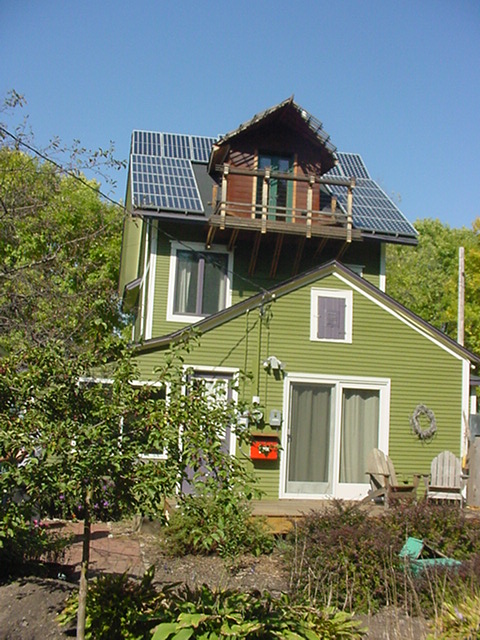
Their home had the most amazing spiral staircase to the very top level with a tree trunk in the middle of the spiral. This one, because it was an old house like mine, was my favorite because they creatively altered it to fit their lives.
And last but not least is Christine Ziebold’s home:
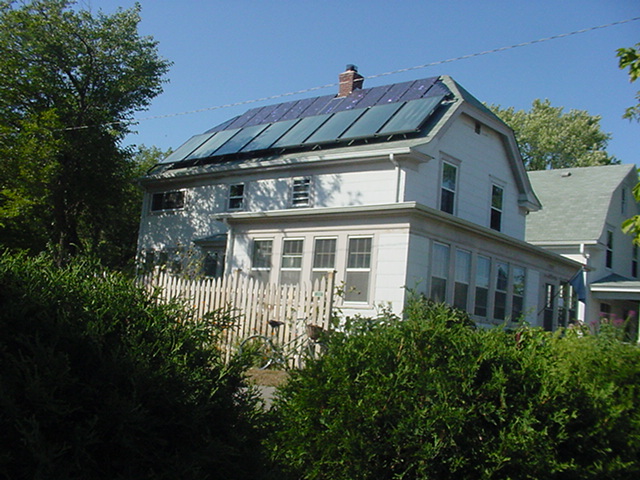
She and John were married last week in Wirth Park (been there, done that, and in Wirth Park too!), and she’s part of a health conference at the U (drat, can’t find the link, name, or anything). They’ve covered every inch of the southern side of the roof with solar, both for heat and electricity, and rave about Ralph Jacobson’s Innovative Power Systems! She says that the only way to go is with someone who can design it, install it, and most importantly, who will be around for service if necessary.
That’s Solar Tour 2005 in a nutshell. There were too many houses to cover, but it was a good excuse to get out and burn up some gas… hmmm… is there something wrong with this picture?
Prairie Island – LaCrosse transmission line in the news!
October 4th, 2005
Today’s article in the LaCrosse Tribune is a lot different than the last one on this blog, which said “New high voltage line unlikely here.” And keep in mind this is not the work of RPU — it’s been in planning for a long time, since it was Option 2 of the WRAO report. And I’ve learned from Greg Woodworth, Engineer at RPU, that it even goes back to a study in 1978! Look at who the big beneficiaries are of this project, those with the generation that they want to ship long distances… who might that be?

Published – Monday, October 03, 2005
Proposed 345,000-volt line would cut through La Crosse County
By REID MAGNEY / La Crosse Tribune
.
A major new power line might be coming to La Crosse.Several electric utilities want to run a 345-kilovolt power line from eastern Minnesota to northern La Crosse County by 2011, and eventually extend it to central Wisconsin.
Utilities say existing lines are inadequate and they need a high-voltage line connecting Xcel Energy’s Prairie Island nuclear reactor and Wisconsin Power & Light’s Columbia coal plant to meet growing demand in the Rochester, Minn., and La Crosse areas.
“We want to improve the reliability and the stability of the system,” said Chuck Callies, vice president of power delivery for Dairyland Power Cooperative, one of the utilities involved in the plan.
“For long term service to (La Crosse), a 345-kV facility looks like the best value for our customers,” said Don Jones, transmission portfolio director for Xcel Energy.
But watchdogs say the utilities are overbuilding high-voltage lines just so they can sell power generated in Minnesota and the Dakotas to customers in southern Wisconsin and northern Illinois.
Environmentalist Guy Wolf of Stoddard, Wis., said he’s concerned about the 345-kilovolt line “creating an incredible scenario of new dirty coal and old toxic nuclear for our energy future.”
“Do we even need this line? And will this line kill any chance of smaller, renewable energy?” Wolf said.
“We are at a crossroads,” said Carol Overland, an attorney from Northfield, Minn., who opposes the new line. “If they build the transmission lines, the big, polluting generation will come. Is this the energy future we want?”
Transmission plans
Plans to connect Xcel Energy’s Prairie Island nuclear plant and Wisconsin Power & Light’s Columbia coal plant near Portage, Wis., have been on the drawing board for many years, including the Wisconsin power line study that recommended the controversial Arrowhead-Weston line from Duluth, Minn., to Wausau, Wis.
Minnesota utilities, including Xcel Energy, have formed CapX 2020 to plan for the next 15 years of transmission projects. Individual utilities are expected to seek certificates of need for six major projects in the coming year or so.
One of those projects is the estimated $200 million, 345-kV line from Prairie Island to Rochester to north La Crosse. They will file with Minnesota’s Public Utilities Commission for a certificate of need in the first quarter of 2006.
Rochester’s needs
The Prairie Island-Rochester-La Crosse line idea grew out of Rochester Public Utilities’ need for more power and better reliability, said Scott Nickels, senior electrical engineer for the utility.
RPU considered adding another 161-kV line from Prairie Island, but decided to build a 345-kV line because it would meet Rochester’s needs until 2051 instead of 2023, he said.
However, getting a certificate of need for a 345-kV line from Prairie Island to Rochester might be a problem, so RPU decided to make the project regional and include La Crosse, Nickels said.
Even though Dairyland will be involved in the 345-kV project, they will only be using about 15 percent of the line’s capacity, said Dairyland’s Callies. Xcel, RPU and Southern Minnesota Municipal Power Agency also would participate.
Grid needs
The largest high-voltage lines in the Coulee Region now carry 161-kV, and aren’t adequate to move power through the area or handle new generation sources, Callies said.
Much of the La Crosse is served by Xcel Energy, but most of its power comes through 161-kV lines connecting Dairyland’s coal plants in Genoa and Alma, Wis., which will be upgraded in coming years.
Wisconsin’s transmission system is the country’s most congested, which “raises costs,” Callies said.
When Dairyland can’t bring power in from the outside, it has to fire up smaller gas turbines, which produce peak power at several times the cost of coal, he said.
Jones said a connection between Prairie Island and Columbia has been on the drawing board for many years. However, connecting to the Columbia plant isn’t as important as tying into another 345 kV line somewhere in eastern Wisconsin.
Creating such a loop would give the La Crosse area access to lower-cost energy, Jones said.
But Wolf said he’s concerned bringing in power from outside plants will discourage development of smaller, renewable energy sources, such as wind and solar.
“Either it (the state) sides with multinational utilities and transmission companies, importing dirty coal and tons of mercury while continuing to lose good-paying jobs, or it will decide on a future that promises a clean, sustainable energy future, with the promise of locally produced renewable energy that will increase its tax base, build local economies, all while improving the health of its citizens,” Wolf said.
But Callies and Jones said western Wisconsin’s power grid isn’t adequate to handle the kind of local power generation Wolf wants.
“The project will benefit everybody because it will relieve congestion that now prohibits people from doing renewable energy,” Callies said.
The system is so congested now that even small projects have to be reviewed before they can go on line, he said. A 6 megawatt generator powered by landfill gas in Washburn County can only deliver 3 mW because of limited transmission, he said.
Who’s right?
“Both sides are right,” said Charlie Higley, executive director of Wisconsin’s Citizen’s Utilities Board. “It’s well established that the electrical system in western Wisconsin is not as robust as other parts of the state.”
But Higley said Overland and Wolf also are correct that larger power lines would allow utilities to bring in power from coal and nuclear plants.
“We need to build what’s needed and no more,” Higley said. “But what’s the right amount?”
He compared the electric grid to a highway system. “Only so many cars can drive on a two-lane highway before it gets dangerous,” Higley said. “We may need a four-land road.”
The states of Wisconsin and Minnesota need to make sure their utilities are working together on transmission planning, Higley said. And the public also needs to become more involved in monitoring plans.
Reid Magney can be reached at (608) 791-8211 or rmagney@lacrossetribune.com.
Check the sidebar!
Exactly where would the power line go?
And there’s this blog listed as a resource…
PI-LaCrosse – Another transmission LIE
October 2nd, 2005
You’d think I’d be used to it by now, but somehow it still bothers me when utilities lie. Here we go again…
Remember last week’s post about the “Phase I” transmission plans roaring through the state? In a letter dated September 5, 2005, all the big Minnesota transmission utilities had grouped together under the CapX2020 umbrella and said that three groups of projects were going forward, including a line from Prairie Island to Rochester to LaCrosse.

Well, I got a call last week, saying, how is it possible? Just the month before, they’d said “American Transmission Company determined that a new line from Portage, Wis., to Red Wing, Minn., would be too long, too expensive and have a high potential for environmental and land-use impacts.” THEY SAID WHAT??? Here’s the article:
New high-voltage line unlikely here
By REID MAGNEY / La Crosse Tribune
Thursday, August 25, 2005A power line company considered, but isn’t actively pursuing, a high-voltage power line from Wisconsin to Minnesota that could come through the Coulee Region.
American Transmission Company determined that a new line from Portage, Wis., to Red Wing, Minn., would be too long, too expensive and have a high potential for environmental and land-use impacts.
Despite a published report indicating a line could come through the La Crosse area, ATC spokeswoman Annemarie Newman said ATC’s study did not look at routes. La Crosse is not mentioned anywhere in ATC’s filing with the Wisconsin Public Service Commission.
ATC is looking for ways to beef up Wisconsin’s electrical infrastructure, and has asked the PSC for guidance on one major project to pursue.
Newman said they’re concentrating on other new lines that would bring power from northern Illinois and Iowa.
However, Newman said ATC believes connecting the Columbia coal plant in Portage and the Prairie Island nuclear plant in Red Wing would be worth pursuing if utilities in neighboring states were interested.
The 275-mile project would cost $640 million and require 159 miles of new right of way, according to the PSC filing.
Xcel Energy spokesman Brian Elwood said Xcel is working to upgrade its high-voltage transmission line between Stillwater, Minn., and Wausau, Wis.
Improvements to that line will benefit La Crosse, he said.
Reid Magney can be reached at (608) 791-8211 or rmagney@lacrossetribune.com.
And to refresh your memory, we’re talking about the WRAO Option 2, from Prairie Island to LaCrosse to Columbia. The descriptions of the Options are on page 7, and a map is on page 8. Specifics of the project are in Appendix C, page C1-2.
So now who do we believe? Should we believe ATC’s Annamarie Newman saying they “considered” the line but eliminated it? Even though ATC’s 10 Year Plan shows the Wisconsin side of the PI-LaX project — it’s that nearly horizontal line on the left:
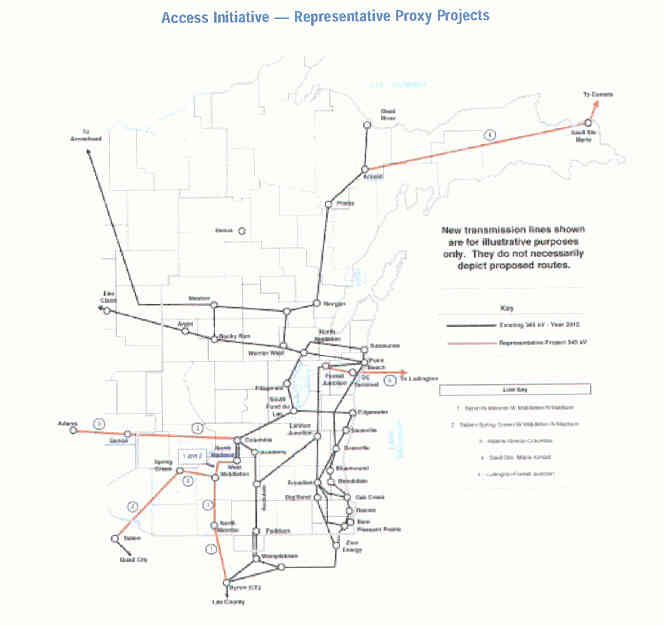
Or should we believe the September 6, 2005 letter from William Kaul of GRE, for CapX2020, which includes Central Minnesota Municipal Power Agency, Great River Energy, Minnesota Power, Minnkota Power, Missouri River Energy Services, OtterTail Power, Southern Minnesota Municipal Power Agency and Xcel Energy?
Something tells me we ought to believe the WRAO Report, the written ATC 10 Year Plan and the eight CapX2020 utilities, and believe that the Prairie Island line is going forward. The Rochester study says it’s only a matter of ATC’s decision of whether that line goes east or south from LaCrosse, and again, my money’s on BOTH EAST AND SOUTH!
Lying… I hate it when that happens…